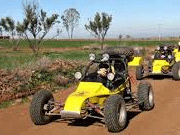
Dune Buggy

The dune buggy (or off-road buggy) originated as a custom built off-road machine based on the Volkswagen Beetle ("Bug") chassis and engine. The high reliability and simplicity of the air-cooled motor lent itself well to use in desert areas of the US Southwest and Mexico, and hence the term "Dune Buggy" was coined. Since that time, the dune buggy design has evolved to cover a wide variety of off-road terrains and purposes, including racing.
Dune/Off-road buggies are characterized today by a scratch-built tube frame chassis, rear or mid-engine and rear or four wheel drive. They utilize treaded, knobby or sand paddle type tires mounted to a large travel suspension front and rear that enables the vehicle to travel over very rough terrain and jumps.
Racing events are held on dirt roads and on desert, wooded, and other natural terrain. Racing is held in many parts of the world, with the most well known races happening in the Mexico (Baja) and Africa (i.e. The Paris-Dakar).
| Power and Weight Stats | |
| Horsepower (Typical Range) | 12-250 |
| Race Weight (Typical Range) | 385-544 kg 850-1200 lb |
Design and Construction
Race Car Models of This Type
Superbuggy, Buggy1600, JuniorBuggy (European Autocross), SCORE classes
Build Your Own Dune Buggy
Knowledge Level
Due to the scratch-built nature of off-road buggies, you should be knowledgeable in handling, chassis, suspension, powertrain, aerodynamic and safety design. These six major areas of the car design work as an integrated unit and the designer must have an understanding of how changes to one area affect the others. Much of the design work is iterative, meaning re-designing areas based on new changes to another area. After the iterations are completed, the design will be complete and optimized.
Because of the varied environments where off-road buggies can operate, knowledge of the terrain is important to ensure the vehicle will handle the demands of the surface and speed.
Design Challenges
Weight Distribution: Typically the front will be lighter in front/rear weight distribution due to the rear/mid-engine configuration. Left/right weight distribution will usually be 50/50.
Suspension: Maximizing the contact patch of the tires with good suspension geometry is of key importance. Because of the long suspension travel there can be significant camber change. Some camber may be of benefit in cornering, but excessive camber will likely mean less traction. Body roll may also be an issue if not properly controlled.
Suspension, wheel and tire weights (Unsprung weight) affect the compliance of the suspension, which in turn affects handling, so keeping all these components as light as possible is an advantage. Springs and dampers (shock absorber) must be matched to the calculated forces.
The suspension pickup point locations impact the chassis design.
Chassis: Providing openings to make internal components accessible for maintenance is important.
Powertrain: Weight distribution is heavily impacted by engine position. Intake, Cooling and exhaust need to be considered in relation to chassis design, bodywork and aerodynamics.
Aerodynamic: Minimizing the drag created by the bodywork frontal area is important to maximize speed on long high speed runs. Wings and other aero devices may be of significant help if the racing takes place on a circuit with high speed corners.
Safety: Providing a substantial crash/rollover safety cell for the driver is vital. A racing seat and harness are also mandatory. Protection for fuel storage, fire protection, and bumpers are recommended if not mandatory in racing.
If you intend to race under a sanctioning body, always read and understand the regulations of your chosen racing class before designing or building any race vehicle.
Design Resources
Learn the basics about race cars and race car design from our free online knowledge series
Download our free race car design aids to assist you designing your race vehicle.
In-depth books and learning resources we recommend for dune buggy design.
Join our forum to ask and find answers to your dune buggy design/construction questions.
Construction Challenges
Ensuring the chassis is dimensionally accurate and straight is important as flaws in the structure will create handling issues via misaligned suspension. The use of a solid, flat and level build space is important. Jigs are often used in this case to ensure that structural tubing stays in alignment during welding/brazing.
The builder should have solid joining and metal working knowledge and skills when fabricating the chassis/rollcage/suspension. While mild steel (1018/1020) is very forgiving, some metals are best welded using a specific method (mig/tig) and some require heat treatments before and following welding to restore their toughness and strength.
Having sufficient space for the chassis and bodywork construction is important, as a cramped workshop can be difficult to work in.
The tools to fabricate the chassis and bodywork can add considerably to the cost of your project if you don't already have a workshop, but borrowing or renting items is also an option.
Build Costs
Many components for an amateur-built dune buggy can be sourced from small production cars (i.e. Mini) instead of being fabricated if doing so is acceptable. This will lower the overall cost.
If the buggy is to be used in racing, there will likely be a higher standard of build quality required, the cost of which will be significantly more than for someone who wants to zip around their back yard. Costs for a race quality machine usually include higher quality suspension, engine and safety components.
Build Effort
Because the buggy is scratch-built, there will be significant effort in design and construction. There is however, an equally great satisfaction and sense of accomplishment at being one of the few people in the world who have built their own race car from the ground up!
Racing Cost
Consumable costs depend on the seriousness of the racing—Tires probably form the single largest consumable expense along with engine rebuilds and suspension part replacements. A dirty or gritty working environment will usually translate into parts wearing out sooner.
Transportation and Support Equipment
Trailering required.

